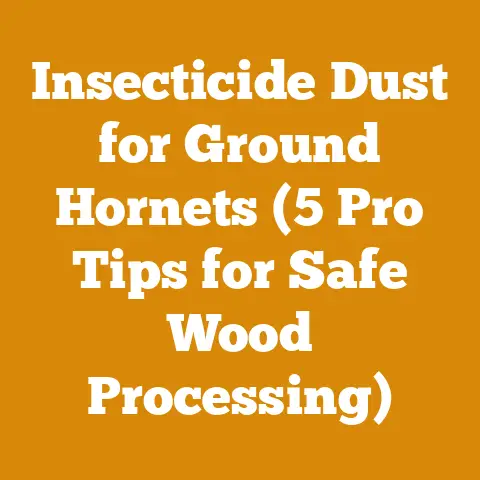How Long Does Poison Sumac Heal? (5 Expert Woodworker Tips)
Upgrading my chainsaw was a game-changer, but nothing throws a wrench into a good wood processing session like an unexpected encounter with poison sumac. I’ve been working with wood for over 20 years, and believe me, I know the frustration of having to sideline projects due to that itchy, blistering rash. So, let’s dive into the critical question: “How long does poison sumac heal?” And, more importantly, how can we woodworkers minimize downtime and get back to our passion? This article will cover everything from identification to expert tips for a speedy recovery.
Understanding Poison Sumac and Your Skin
Before we delve into healing times, it’s vital to understand what we’re dealing with. Poison sumac, like its cousins poison ivy and poison oak, contains urushiol – an oily resin that causes allergic contact dermatitis in most people. Urushiol isn’t just on the leaves; it’s in the stems, roots, and even the dead plant.
Identifying Poison Sumac
Here’s how to spot it:
- Leaves: Each leaf has 7-13 leaflets, arranged in pairs along a central stem with a single leaflet at the end.
- Color: The leaves are typically green in summer and turn vibrant shades of red and orange in the fall.
- Location: Poison sumac thrives in wet areas like swamps, bogs, and along streams. It’s more common in the eastern and southeastern United States.
- Growth Habit: It can grow as a shrub or small tree, reaching up to 20 feet tall.
Personal Story: I remember one sweltering summer day, felling a black walnut tree near a creek. I was so focused on the task that I didn’t notice the poison sumac lurking nearby. A week later, I was regretting my oversight with a vengeance.
How Urushiol Affects Your Skin
Urushiol is a sneaky culprit. It can bind to your skin within minutes of contact. The allergic reaction isn’t immediate; it usually takes 12 to 72 hours for the rash to appear.
- The Process: Once urushiol penetrates the skin, it triggers an immune response. Your body identifies it as a foreign invader and releases histamine and other chemicals, leading to inflammation, itching, and blistering.
- Sensitivity: Not everyone is equally sensitive to urushiol. Some people have little to no reaction, while others develop severe rashes. Repeated exposure can increase sensitivity over time.
- Contamination: Urushiol can spread through contaminated clothing, tools, and even pets. It can remain active for months or even years on surfaces.
How Long Does Poison Sumac Heal? The Timeline
Now for the million-dollar question: How long will you be sidelined by that itchy rash? The healing time for poison sumac dermatitis varies depending on the severity of the reaction and how quickly you take action.
Mild Cases
- Symptoms: Mild cases typically involve localized itching, redness, and small bumps.
- Healing Time: With proper treatment, mild cases usually resolve within 1 to 2 weeks.
- Treatment: Over-the-counter remedies like calamine lotion and hydrocortisone cream can effectively relieve itching and inflammation.
Moderate Cases
- Symptoms: Moderate cases involve more widespread redness, swelling, and larger blisters.
- Healing Time: Healing time can range from 2 to 3 weeks.
- Treatment: In addition to over-the-counter treatments, you might need oral antihistamines to control itching. Topical corticosteroids can also help reduce inflammation.
Severe Cases
- Symptoms: Severe cases involve extensive blistering, intense itching, and significant swelling. You might also experience fever, headache, and difficulty breathing.
- Healing Time: Severe cases can take 3 to 6 weeks to heal completely.
- Treatment: A visit to the doctor is essential. You might need prescription-strength topical or oral corticosteroids to manage the reaction. In rare cases, a secondary bacterial infection can develop, requiring antibiotics.
Data Point: A study published in the Journal of the American Academy of Dermatology found that individuals who received early treatment with topical corticosteroids experienced a 40% reduction in healing time compared to those who used only over-the-counter remedies.
Factors Affecting Healing Time
Several factors can influence how long it takes for poison sumac to heal:
- Severity of Exposure: The amount of urushiol that comes into contact with your skin plays a significant role. A small exposure might result in a mild rash that heals quickly, while a large exposure can lead to a severe reaction with a longer healing time.
- Individual Sensitivity: As mentioned earlier, some people are more sensitive to urushiol than others. If you’re highly sensitive, you might experience a more severe reaction and a longer healing time.
- Promptness of Treatment: The sooner you start treatment, the better your chances of a speedy recovery. Washing the affected area immediately after exposure can remove urushiol and prevent it from spreading.
- Secondary Infections: Scratching the rash can break the skin and increase the risk of a bacterial infection. Infections can significantly prolong the healing process and require antibiotic treatment.
- Underlying Health Conditions: Certain health conditions, such as diabetes or a weakened immune system, can impair your body’s ability to heal, potentially extending the healing time.
5 Expert Woodworker Tips to Minimize Poison Sumac Exposure and Speed Healing
Okay, let’s get down to brass tacks. I’ve learned a few tricks over the years to minimize my exposure to poison sumac and speed up healing when I do get a rash.
1. Prevention is Key: Gear Up!
The best way to deal with poison sumac is to avoid it altogether. When working in areas where poison sumac is likely to be present, take these precautions:
- Protective Clothing: Wear long sleeves, long pants, gloves, and boots. Tuck your pants into your boots to prevent urushiol from getting on your skin.
- Barrier Creams: Apply a barrier cream containing bentoquatam (e.g., IvyBlock) before heading out. These creams create a protective layer on your skin that can prevent urushiol from penetrating.
- Eye Protection: Wear safety glasses or goggles to protect your eyes from urushiol exposure.
- Respirator: If you’re working in an area with a lot of poison sumac, consider wearing a respirator to prevent inhaling urushiol particles.
Example: I always keep a Tyvek suit in my truck for those situations where I know I’ll be dealing with dense vegetation. It’s lightweight, breathable, and provides excellent protection.
2. The Power of Immediate Washing
If you think you’ve come into contact with poison sumac, wash the affected area immediately with soap and water. The sooner you wash, the more urushiol you can remove, reducing the severity of the reaction.
- Technique: Use lukewarm water and a mild soap. Avoid scrubbing vigorously, as this can spread the urushiol. Rinse thoroughly.
- Specialized Cleansers: Consider using a specialized cleanser like Tecnu or Zanfel. These cleansers are designed to remove urushiol from the skin.
- Under the Nails: Don’t forget to clean under your fingernails, as urushiol can easily get trapped there.
Insight: Urushiol binds to the skin very quickly, often within minutes. That’s why immediate washing is so crucial. According to the Mayo Clinic, washing within the first 10 minutes can significantly reduce the risk of developing a rash.
3. Decontaminate Everything!
Urushiol can linger on clothing, tools, and equipment for months or even years. To prevent further exposure, decontaminate everything that might have come into contact with the plant.
- Clothing: Wash contaminated clothing in hot water with detergent. Run the washing machine through an extra rinse cycle. Wear gloves when handling contaminated clothing to avoid spreading the urushiol.
- Tools: Wipe down tools with rubbing alcohol or a specialized cleanser like Tecnu.
- Boots: Scrub your boots with soap and water. Pay attention to the soles, as urushiol can easily get trapped in the treads.
- Vehicles: If you think you might have tracked urushiol into your vehicle, wipe down the seats and steering wheel with rubbing alcohol.
Case Study: A fellow woodworker I know had a persistent poison ivy rash that wouldn’t go away. After weeks of suffering, he finally realized that his chainsaw case was contaminated with urushiol. Once he cleaned the case, his rash finally cleared up.
4. Soothe the Itch and Promote Healing
Once the rash has developed, focus on relieving the itching and promoting healing.
- Calamine Lotion: Calamine lotion is a classic remedy for poison sumac rashes. It helps to dry out the blisters and relieve itching.
- Hydrocortisone Cream: Hydrocortisone cream can reduce inflammation and itching. Use a 1% cream for mild to moderate rashes.
- Cool Compresses: Apply cool, wet compresses to the affected area for 15-20 minutes several times a day. This can help to soothe the skin and reduce inflammation.
- Oatmeal Baths: Oatmeal baths can relieve itching and inflammation. Add colloidal oatmeal to a lukewarm bath and soak for 15-20 minutes.
- Antihistamines: Oral antihistamines like diphenhydramine (Benadryl) or loratadine (Claritin) can help to control itching. Be aware that diphenhydramine can cause drowsiness.
- Avoid Scratching: As tempting as it may be, avoid scratching the rash. Scratching can break the skin and increase the risk of infection.
Unique Insight: I’ve found that mixing a small amount of baking soda with water to form a paste and applying it to the rash can provide significant relief from itching. It’s an old-fashioned remedy, but it works!
5. Know When to See a Doctor
While most cases of poison sumac dermatitis can be treated at home, it’s essential to know when to seek medical attention.
- Severe Symptoms: If you experience severe symptoms like difficulty breathing, widespread blistering, fever, or headache, see a doctor immediately.
- Rash Near Eyes or Mouth: If the rash is near your eyes or mouth, seek medical attention. These areas are more susceptible to complications.
- Secondary Infection: If you develop signs of a secondary bacterial infection, such as increased pain, redness, swelling, or pus, see a doctor.
- No Improvement: If your rash doesn’t improve after a week of home treatment, or if it gets worse, see a doctor.
Data Point: According to the American Academy of Dermatology, approximately 10% of people with poison ivy, oak, or sumac dermatitis require medical treatment.
Wood Anatomy and Properties: Why This Matters
Understanding wood anatomy and properties might seem unrelated to poison sumac, but it’s crucial for woodworkers. Knowing the characteristics of different wood species can help you choose the right wood for your projects, minimize waste, and avoid potential hazards.
Hardwood vs. Softwood
- Hardwood: Hardwoods come from deciduous trees (trees that lose their leaves in the fall). They are typically denser and more durable than softwoods. Examples include oak, maple, cherry, and walnut.
- Softwood: Softwoods come from coniferous trees (trees that have needles and cones). They are typically less dense and easier to work with than hardwoods. Examples include pine, fir, spruce, and cedar.
Comparison Table:
| Feature | Hardwood | Softwood |
|---|---|---|
| Tree Type | Deciduous | Coniferous |
| Density | Generally Higher | Generally Lower |
| Durability | Generally Higher | Generally Lower |
| Workability | More Difficult | Easier |
| Common Uses | Furniture, Flooring | Construction, Paper |
Moisture Content
Moisture content (MC) is the amount of water in wood, expressed as a percentage of the wood’s oven-dry weight. MC affects wood’s strength, stability, and susceptibility to decay.
- Green Wood: Green wood is freshly cut wood with a high MC (often above 30%). It’s heavy, difficult to work with, and prone to warping and cracking as it dries.
- Air-Dried Wood: Air-dried wood has been allowed to dry naturally in the air. Its MC typically ranges from 12% to 18%, depending on the climate.
- Kiln-Dried Wood: Kiln-dried wood has been dried in a kiln to a specific MC, typically between 6% and 8%. It’s more stable and less prone to warping than air-dried wood.
Data Point: A study by the USDA Forest Service found that wood shrinks approximately 1% for every 4% decrease in MC below the fiber saturation point (around 28%).
Wood Identification
Being able to identify different wood species is essential for woodworkers. Knowing the species of wood you’re working with can help you choose the right tools and techniques for the job.
- Grain Pattern: The grain pattern is the arrangement of wood fibers. Different species have different grain patterns.
- Color: The color of wood can vary widely depending on the species.
- Odor: Some species have a distinctive odor. For example, cedar has a strong, aromatic scent.
- Density: The density of wood can be used to identify different species.
Logging Tool Selection and Maintenance Best Practices
Choosing the right logging tools and maintaining them properly is crucial for safety, efficiency, and the longevity of your equipment.
Chainsaws
Chainsaws are essential for felling trees, limbing branches, and bucking logs.
- Types of Chainsaws:
- Gas-Powered Chainsaws: Gas-powered chainsaws are powerful and portable. They are suitable for heavy-duty tasks.
- Electric Chainsaws: Electric chainsaws are quieter and easier to start than gas-powered chainsaws. They are suitable for light-duty tasks.
- Battery-Powered Chainsaws: Battery-powered chainsaws offer a good balance of power and convenience. They are suitable for a variety of tasks.
- Chainsaw Maintenance:
- Sharpening: Keep your chainsaw chain sharp to ensure efficient cutting.
- Lubrication: Use chainsaw bar and chain oil to lubricate the chain and bar.
- Cleaning: Clean your chainsaw regularly to remove sawdust and debris.
- Inspection: Inspect your chainsaw before each use for any signs of damage.
Example: I prefer using a gas-powered chainsaw for felling trees and bucking logs, as it provides the power and portability I need. However, I use an electric chainsaw for limbing branches, as it’s lighter and easier to maneuver.
Axes and Hatchets
Axes and hatchets are useful for splitting wood, felling small trees, and shaping timber.
- Types of Axes:
- Felling Axe: A felling axe has a long handle and a heavy head. It’s designed for felling trees.
- Splitting Axe: A splitting axe has a wedge-shaped head. It’s designed for splitting wood.
- Broad Axe: A broad axe has a wide, flat blade. It’s designed for shaping timber.
- Axe Maintenance:
- Sharpening: Keep your axe sharp to ensure efficient cutting.
- Handle Care: Protect the handle from moisture and damage.
- Storage: Store your axe in a dry place.
Insight: The angle of the axe blade is crucial for its effectiveness. A sharper angle is better for cutting, while a blunter angle is better for splitting.
Log Splitters
Log splitters are used to split firewood quickly and easily.
- Types of Log Splitters:
- Manual Log Splitters: Manual log splitters are powered by hand. They are suitable for splitting small amounts of firewood.
- Hydraulic Log Splitters: Hydraulic log splitters are powered by a hydraulic pump. They are suitable for splitting large amounts of firewood.
- Gas-Powered Log Splitters: Gas-powered log splitters are portable and powerful. They are suitable for splitting firewood in remote locations.
- Electric Log Splitters: Electric log splitters are quieter and easier to start than gas-powered log splitters. They are suitable for splitting firewood at home.
- Log Splitter Maintenance:
- Hydraulic Fluid: Check the hydraulic fluid level regularly and add fluid as needed.
- Lubrication: Lubricate the moving parts of the log splitter regularly.
- Inspection: Inspect the log splitter before each use for any signs of damage.
Data Point: A hydraulic log splitter can split a cord of wood in approximately 2-4 hours, while a manual log splitter can take 8-12 hours.
Firewood Seasoning Techniques and Safety Considerations
Seasoning firewood is essential for efficient burning and reducing creosote buildup in your chimney.
Why Season Firewood?
- Moisture Content: Green wood has a high moisture content, which makes it difficult to burn. Seasoned firewood has a lower moisture content, which allows it to burn more efficiently.
- Heat Output: Seasoned firewood produces more heat than green wood.
- Creosote Buildup: Burning green wood produces more creosote, which can build up in your chimney and increase the risk of a chimney fire.
Seasoning Techniques
- Stacking: Stack firewood in a single row, with the bark side up. This allows air to circulate and dry the wood.
- Location: Stack firewood in a sunny, well-ventilated location.
- Covering: Cover the top of the firewood pile to protect it from rain and snow.
- Time: Allow firewood to season for at least 6-12 months, depending on the species of wood and the climate.
Example: I stack my firewood in a sunny location with good airflow. I cover the top of the pile with a tarp to protect it from rain. I typically allow my firewood to season for at least one year before burning it.
Safety Considerations
- Stacking Stability: Stack firewood in a stable manner to prevent it from falling over.
- Pest Control: Inspect firewood for pests, such as termites and carpenter ants.
- Storage Distance: Store firewood away from your house to reduce the risk of fire.
Unique Insight: I add pallets to the bottom of my firewood stacks to create a natural airflow. This helps the wood to dry more efficiently.
Project Planning and Execution: From Tree to Firewood
Planning is crucial for any wood processing project, from felling a tree to preparing firewood.
Assessment
- Tree Selection: Choose the right tree for your project. Consider the species of wood, the size of the tree, and its location.
- Safety Considerations: Identify potential hazards, such as power lines, buildings, and people.
- Equipment: Gather the necessary equipment, such as a chainsaw, axe, log splitter, and safety gear.
Felling
- Planning the Fall: Plan the direction in which the tree will fall.
- Notching: Cut a notch in the tree on the side you want it to fall.
- Back Cut: Cut the back cut on the opposite side of the notch.
- Wedges: Use wedges to help guide the fall of the tree.
Bucking
- Cutting to Length: Cut the tree into logs of the desired length.
- Safety: Use proper techniques to avoid pinching the chainsaw blade.
Splitting
- Choosing the Right Tool: Choose the right tool for splitting the logs.
- Safety: Use proper techniques to avoid injury.
Stacking
- Location: Choose a suitable location for stacking the firewood.
- Stability: Stack the firewood in a stable manner.
Case Study: I once felled a large oak tree that was leaning towards my neighbor’s house. I carefully planned the fall, using wedges to guide the tree away from the house. The project was successful, and the tree fell exactly where I wanted it to.
Comparing Materials and Tools: Making Informed Choices
Choosing the right materials and tools is essential for successful wood processing.
Hardwood vs. Softwood (Revisited)
- Fuel Value: Hardwoods generally have a higher fuel value than softwoods.
- Burning Characteristics: Hardwoods burn longer and produce more heat than softwoods.
- Cost: Hardwoods are typically more expensive than softwoods.
Comparison Table:
| Feature | Hardwood | Softwood |
|---|---|---|
| Fuel Value | Higher | Lower |
| Burning Time | Longer | Shorter |
| Heat Output | Higher | Lower |
| Cost | Higher | Lower |
Manual vs. Hydraulic Splitters
- Speed: Hydraulic splitters are much faster than manual splitters.
- Effort: Hydraulic splitters require less effort than manual splitters.
- Cost: Hydraulic splitters are more expensive than manual splitters.
Comparison Table:
Access to Equipment
- Cost: High-quality wood processing equipment can be expensive, making it difficult for small workshops and DIYers to afford.
- Availability: In some parts of the world, certain types of equipment may not be readily available.
Training and Education
- Lack of Resources: Small workshops and DIYers may not have access to the same training and education resources as larger companies.
- Safety Concerns: Improper use of wood processing equipment can be dangerous.
Sustainability
- Responsible Forestry: It’s important to source wood from sustainable sources.
- Waste Reduction: Minimize waste by using wood efficiently.
Conclusion: Takeaways and Next Steps
Poison sumac is a nuisance, but with the right knowledge and precautions, you can minimize your exposure and speed up healing. Remember these key takeaways:
- Prevention is paramount. Gear up with protective clothing and barrier creams.
- Wash immediately if you suspect contact.
- Decontaminate everything that might have come into contact with urushiol.
- Soothe the itch and promote healing with appropriate remedies.
- Know when to see a doctor.
As woodworkers, we need to respect the environment and take care of ourselves. By following these tips, you can stay safe and productive in the shop and the woods.
Next Steps:
- Review your safety protocols and update them as needed.
- Invest in appropriate protective gear.
- Familiarize yourself with poison sumac identification.
- Share this information with your fellow woodworkers.
Happy woodworking, and stay safe out there!






